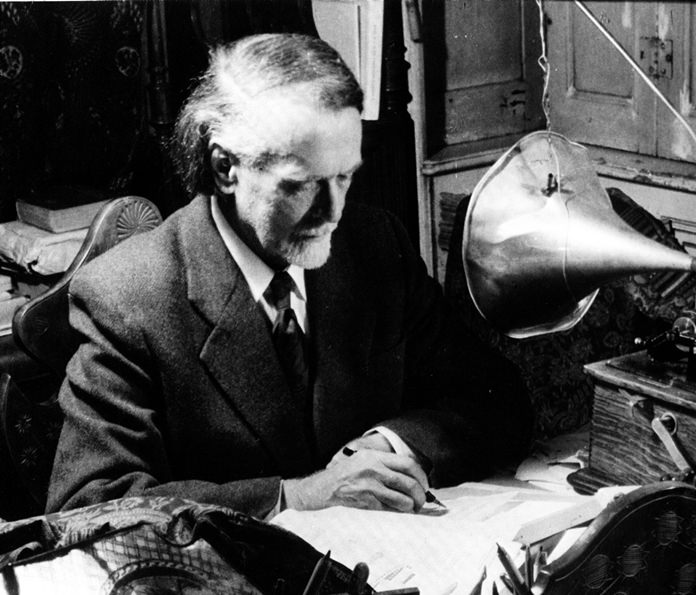One of the most influential Hungarian composers of the early twentieth century was Zoltán Kodály, who was born on 16th December. Because of his interest in music education he became known in Hungary primarily as an educator and he wrote several influential books on the subject.

Oddly enough Zoltán Kodály (zohl-TAHN koh-DAH-yee) is most closely associated with a teaching aid he didn’t actually invent: the hand signs. The so-called Kodály hand signs were devised in the mid-nineteenth century by an English minister, John Curwen. Each hand position (or shape) represents a note of the scale and after being adopted by Kodály the signs were extensively used in elementary schools in both Europe and the USA a means of teaching sight-singing. In many schools, they still are. The hand signs were used in the 1977 movie Close Encounters of the Third Kind, but they didn’t really have much to do with the plot and were perhaps merely included to add a bit of gravitas to a rather implausible scene.
Kodály became interested in children’s music education in 1925 when he happened to hear some school kids singing in the street. He was horrified by their tuneless squawking and drew the conclusion that music teaching in the schools was to blame. He set about a campaign for better teachers, a better curriculum, and more class-time devoted to music. His tireless work resulted in many publications which outlined his approach to musical education and had a world-wide impact. Kodály was also fascinated with Hungarian folksongs and spent many years recording them, initially on phonograph cylinders.
Zoltán Kodály (1882-1967): Háry János Suite. Frankfurt Radio Symphony Orchestra cond. Juraj Valèuha (Duration: 27:46; Video: 720p HD)
Perhaps his devotion to researching and writing about music education and his years collecting folksongs gave him less time to compose because his output is fairly modest. There are a couple of dozen chamber works and choral pieces, a handful of orchestral works, and two operas, one of the which is the folk opera Háry János.
The story is of a veteran soldier in the Austrian army named Háry János who regularly sits in the village inn spinning yarns to his long-suffering listeners with fantastic tales of unlikely heroism, one of which was single-handedly defeating Napoleon and his armies.
The suite, as you might have gathered is a collection of material lifted out of the opera. It forms a pleasing six-movement orchestral work. Both the opera and the suite begin with an orchestral impression of a sneeze, symbolizing the Hungarian belief that a sneeze before the telling of a story indicates that it’s going to be the absolute truth. In the third movement, Kodály adds a bit of local colour by using a cimbalom, a Hungarian dulcimer-like instrument played with beaters.
François-Adrien Boieldieu (1775-1834): Overture: The Caliph of Baghdad. Symphonette Raanana Orchestra, cond. Shmuel Elbaz (Duration: 07:57; Video: 1080p HD)
When I was a teenager living on a stone-grey island far away, I used to play the cello. Every Wednesday evening a group of us young musicians would clamber aboard the local bus taking us on a twenty-mile journey to the rehearsal of the County Orchestra. One of the conductor’s favourite overtures was The Caliph of Baghdad, perhaps because it was relatively easy to play. We seemed to perform it an awful lot. The work came to mind because 16th December is also the birthday of its composer François Boieldieu (BWAL-dee-yuh) who for a time was flatteringly known as “the French Mozart”.
As a teenager, François composed his earliest works using words written by his father and this brought him local success. The opera Le Calife de Bagdad was composed when he was approaching twenty-five and first performed at the classy Théâtre National de l’Opéra Comique in Paris. Incidentally, the word “comique” does not translate as “comical” – it was a popular style of opera in which arias were interspersed with spoken dialogue.
The opera was Boieldieu’s first major triumph and the opera soon became tremendously popular all over Europe. By operatic standards, the story is fairly straightforward and revolves around the main character Isaoun who is the eponymous Caliph. He adopts a disguise so he can roam freely among the streets without being recognised, which of course, he eventually is.
At the time, there was a fashion for operas on Oriental themes and the overture features prominent “eastern” percussion. It’s thought that this opera may have influenced Carl Maria von Weber, particularly his own Eastern-themed opera Abu Hassan.
If these things interest you, the Théâtre National de l’Opéra Comique is still going strong in Paris and you can find it in Place Boieldieu. Yes, named after the composer. But don’t go there just yet in the hope of seeing a show – it’s closed until January 2017 for renovations.
 |
 |
 |





